初中英语语法之动词不定式详解
- 格式:docx
- 大小:21.22 KB
- 文档页数:19
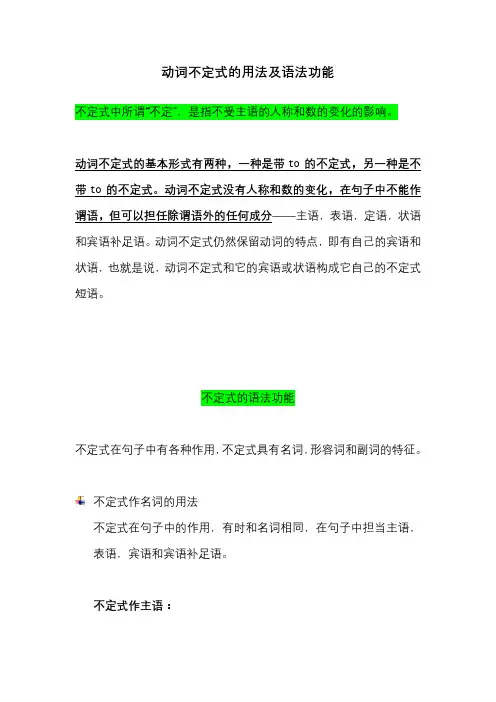
动词不定式的用法及语法功能不定式中所谓“不定”,是指不受主语的人称和数的变化的影响。
动词不定式的基本形式有两种,一种是带to的不定式,另一种是不带to的不定式。
动词不定式没有人称和数的变化,在句子中不能作谓语,但可以担任除谓语外的任何成分——主语,表语,定语,状语和宾语补足语。
动词不定式仍然保留动词的特点,即有自己的宾语和状语,也就是说,动词不定式和它的宾语或状语构成它自己的不定式短语。
不定式的语法功能不定式在句子中有各种作用,不定式具有名词,形容词和副词的特征。
不定式作名词的用法不定式在句子中的作用,有时和名词相同,在句子中担当主语,表语,宾语和宾语补足语。
不定式作主语:常用句型 It is … to …不定式作主语的句子通常用 It is … to+不定式的句型来代替,在句子中it 作形式主语,真正的主语式后面的动词不定式。
在这里,不定式被视为第三人称单数,所以动词要用 is (现在时) 或was (过去时)。
如以下例句所示:It is important to learn English well.It is dangerous to play in the street.It is hard to say goodbye with you.不定式作表语:To do 不定式作表语e.g. The best plan is to leave here. 最好的计划是离开这里。
不定式作宾语:不定式在及物动词后作宾语,常见的及物动词有:Ask, decide, begin, fail, continue, forget, hate, help, like, long, want, wait, manage, need, start, pretend, refuse, try, dare, agree, know, wish, afford 等不定式作副词的用法:不定式有时起副词作用,修饰动词或形容词,在句子中相当于状语,表示目的和原因表目的:-不定式在不及物动词后担当状语e.g. My mom came to see me yesterday evening.-针对why的疑问句回答时,如果表示目的,可用不定式来代替。
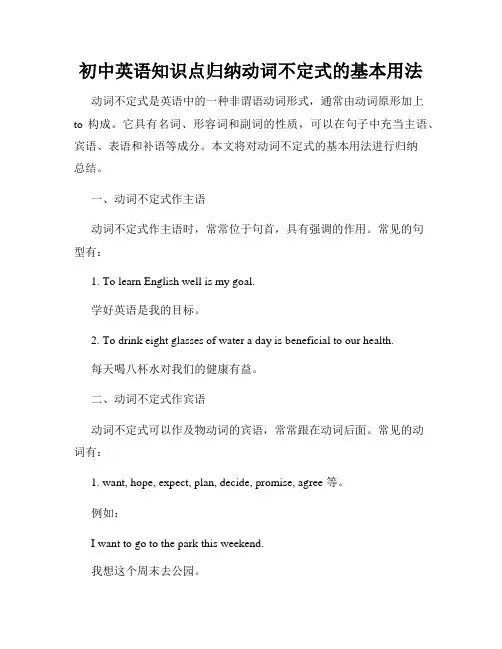
初中英语知识点归纳动词不定式的基本用法动词不定式是英语中的一种非谓语动词形式,通常由动词原形加上to 构成。
它具有名词、形容词和副词的性质,可以在句子中充当主语、宾语、表语和补语等成分。
本文将对动词不定式的基本用法进行归纳总结。
一、动词不定式作主语动词不定式作主语时,常常位于句首,具有强调的作用。
常见的句型有:1. To learn English well is my goal.学好英语是我的目标。
2. To drink eight glasses of water a day is beneficial to our health.每天喝八杯水对我们的健康有益。
二、动词不定式作宾语动词不定式可以作及物动词的宾语,常常跟在动词后面。
常见的动词有:1. want, hope, expect, plan, decide, promise, agree 等。
例如:I want to go to the park this weekend.我想这个周末去公园。
2. advise, encourage, allow, enable, force, teach 等。
例如:His teacher encourages him to learn new words every day.他的老师鼓励他每天学习新单词。
三、动词不定式作表语动词不定式可以作表语,说明主语的身份、职业、愿望等。
常见的句型有:1. His dream is to become a doctor.他的梦想是成为一名医生。
2. Our aim is to win the game.我们的目标是赢得比赛。
四、动词不定式作补语动词不定式可以作及物动词的宾语补语和形容词的补足语。
常见的动词有:1. make, let, see, hear, watch, feel, notice, observe 等。
例如:She made her son do his homework.她让她的儿子做作业。


初中英语语法之动词不定式全解析动词不定式是由“不定式符号to+动词原形”构成的一种非谓语动词结构。
有些动词不定式不带to。
动词不定式可以作句子的主语、表语、宾语、定语、补语、状语或单独使用。
不定式保留动词的某些特性,可以有自己的宾语、状语等。
动词不定式和它后面的宾语、状语等一起构成短语,叫作不定式短语。
下面,小简老师带大家一起学习不定式的语法功能,即在句中做什么成分。
一. 用作主语直接把动词不定式置于句首的情况不多,多数情况用it作形式主语,把真正的主语—动词不定式置于句末,特别是不定式短语较长时。
动词不定式作主语,谓语动词用第三人称单数形式。
带疑问词的不定式短语作主语常置于句首。
1. It is our duty to try our best to deal with these problems.尽最大努力处理这些问题是我们的责任。
2. The head teacher said it was necessary to talk with his mother.校长说,和他妈妈谈一谈很有必要。
3. How to learn English well is important.如何学好英语很重要。
4. To see is to believe.眼见为实;百闻不如一见。
二. 用作表语动词不定式作表语,常说明主语的内容、性质、特征。
如:1. The best way is to join an English club.最好的办法是加入一个英语俱乐部。
2. The first thing is to listen to the teacher carefully.首先是要认真听老师讲课。
三. 用作宾语1. 可以接带to的动词不定式作宾语的动词主要有:要求选择同意(ask, choose, agree);期望决定学习(expect, hope, decide, learn);宁可假装知道(prefer, pretend, know);希望想要愿意(wish, want, would like / love)。

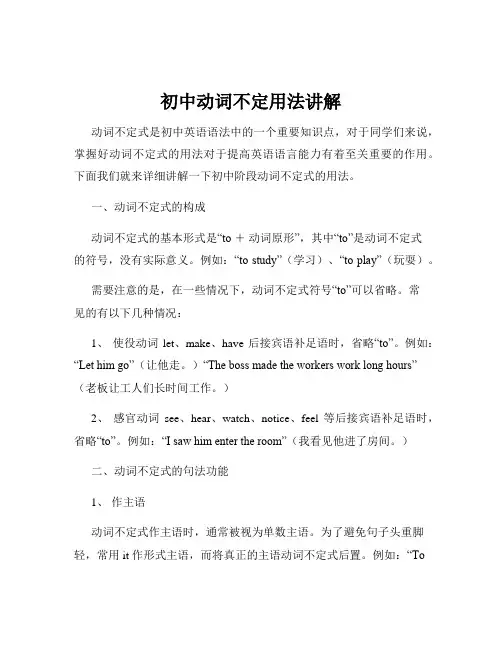
初中动词不定用法讲解动词不定式是初中英语语法中的一个重要知识点,对于同学们来说,掌握好动词不定式的用法对于提高英语语言能力有着至关重要的作用。
下面我们就来详细讲解一下初中阶段动词不定式的用法。
一、动词不定式的构成动词不定式的基本形式是“to +动词原形”,其中“to”是动词不定式的符号,没有实际意义。
例如:“to study”(学习)、“to play”(玩耍)。
需要注意的是,在一些情况下,动词不定式符号“to”可以省略。
常见的有以下几种情况:1、使役动词 let、make、have 后接宾语补足语时,省略“to”。
例如:“Let him go”(让他走。
)“The boss made the workers work long hours”(老板让工人们长时间工作。
)2、感官动词see、hear、watch、notice、feel 等后接宾语补足语时,省略“to”。
例如:“I saw him enter the room”(我看见他进了房间。
)二、动词不定式的句法功能1、作主语动词不定式作主语时,通常被视为单数主语。
为了避免句子头重脚轻,常用 it 作形式主语,而将真正的主语动词不定式后置。
例如:“Tolearn English well is not easy”(学好英语不容易。
)这句话可以改写为:“It is not easy to learn English well”2、作宾语一些动词后面常接动词不定式作宾语,常见的有want、hope、wish、decide、plan、expect 等。
例如:“I want to go home”(我想回家。
)“She decides to study harder”(她决定更努力学习。
)3、作宾语补足语某些动词如 ask、tell、want、allow、encourage 等后面常接带“to”的动词不定式作宾语补足语。
例如:“My mother asks me to clean the room”(我妈妈叫我打扫房间。
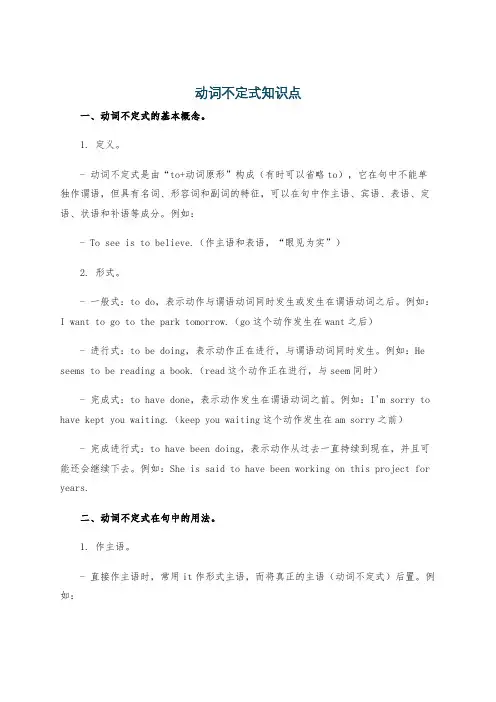
动词不定式知识点一、动词不定式的基本概念。
1. 定义。
- 动词不定式是由“to+动词原形”构成(有时可以省略to),它在句中不能单独作谓语,但具有名词、形容词和副词的特征,可以在句中作主语、宾语、表语、定语、状语和补语等成分。
例如:- To see is to believe.(作主语和表语,“眼见为实”)2. 形式。
- 一般式:to do,表示动作与谓语动词同时发生或发生在谓语动词之后。
例如:I want to go to the park tomorrow.(go这个动作发生在want之后)- 进行式:to be doing,表示动作正在进行,与谓语动词同时发生。
例如:He seems to be reading a book.(read这个动作正在进行,与seem同时)- 完成式:to have done,表示动作发生在谓语动词之前。
例如:I'm sorry to have kept you waiting.(keep you waiting这个动作发生在am sorry之前)- 完成进行式:to have been doing,表示动作从过去一直持续到现在,并且可能还会继续下去。
例如:She is said to have been working on this project for years.二、动词不定式在句中的用法。
1. 作主语。
- 直接作主语时,常用it作形式主语,而将真正的主语(动词不定式)后置。
例如:- It is difficult to learn English well.(真正的主语是to learn English well,it是形式主语)- 但是,当动词不定式作主语的句子中有表语形容词时,也可以直接将动词不定式置于句首。
例如:- To be honest is very important.2. 作宾语。
- 动词不定式可以作某些及物动词的宾语,常见的这类动词有want, hope, wish, decide, manage, expect等。
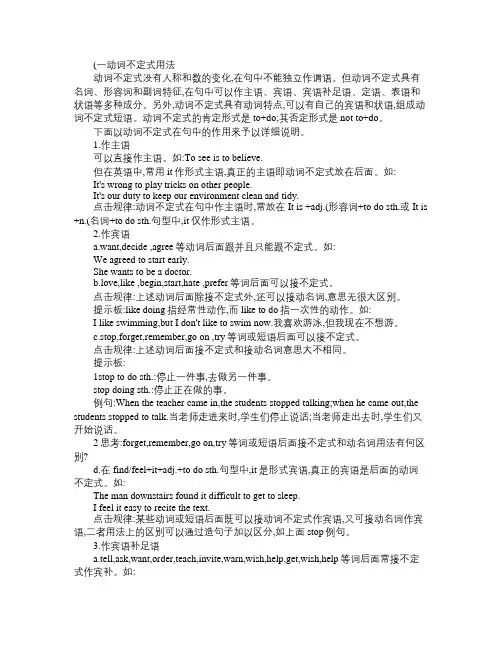
(一动词不定式用法动词不定式没有人称和数的变化,在句中不能独立作谓语。
但动词不定式具有名词、形容词和副词特征,在句中可以作主语、宾语、宾语补足语、定语、表语和状语等多种成分。
另外,动词不定式具有动词特点,可以有自己的宾语和状语,组成动词不定式短语。
动词不定式的肯定形式是to+do;其否定形式是not to+do。
下面以动词不定式在句中的作用来予以详细说明。
1.作主语可以直接作主语。
如:To see is to believe.但在英语中,常用it作形式主语,真正的主语即动词不定式放在后面。
如:It's wrong to play tricks on other people.It's our duty to keep our environment clean and tidy.点击规律:动词不定式在句中作主语时,常放在It is +adj.(形容词+to do sth.或It is +n.(名词+to do sth.句型中,it仅作形式主语。
2.作宾语a.want,decide ,agree等动词后面跟并且只能跟不定式。
如:We agreed to start early.She wants to be a doctor.b.love,like ,begin,start,hate ,prefer等词后面可以接不定式。
点击规律:上述动词后面除接不定式外,还可以接动名词,意思无很大区别。
提示板:like doing指经常性动作,而like to do指一次性的动作。
如:I like swimming,but I don't like to swim now.我喜欢游泳,但我现在不想游。
c.stop,forget,remember,go on ,try等词或短语后面可以接不定式。
点击规律:上述动词后面接不定式和接动名词意思大不相同。
提示板:1stop to do sth.:停止一件事,去做另一件事。
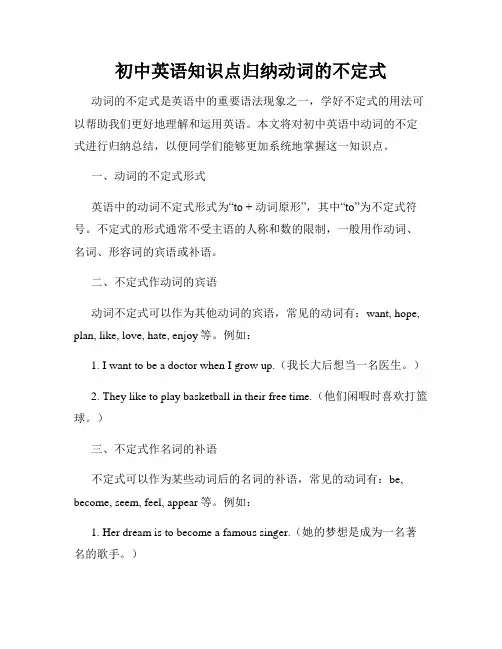
初中英语知识点归纳动词的不定式动词的不定式是英语中的重要语法现象之一,学好不定式的用法可以帮助我们更好地理解和运用英语。
本文将对初中英语中动词的不定式进行归纳总结,以便同学们能够更加系统地掌握这一知识点。
一、动词的不定式形式英语中的动词不定式形式为“to + 动词原形”,其中“to”为不定式符号。
不定式的形式通常不受主语的人称和数的限制,一般用作动词、名词、形容词的宾语或补语。
二、不定式作动词的宾语动词不定式可以作为其他动词的宾语,常见的动词有:want, hope, plan, like, love, hate, enjoy等。
例如:1. I want to be a doctor when I grow up.(我长大后想当一名医生。
)2. They like to play basketball in their free time.(他们闲暇时喜欢打篮球。
)三、不定式作名词的补语不定式可以作为某些动词后的名词的补语,常见的动词有:be, become, seem, feel, appear等。
例如:1. Her dream is to become a famous singer.(她的梦想是成为一名著名的歌手。
)2. It seems to be a nice day for a picnic.(今天似乎是个适合野餐的好天气。
)四、不定式作形容词的补语不定式可以作为某些形容词后的补语,常见的形容词有:happy, sad, glad, ready, willing等。
例如:1. He is happy to help others.(他乐意帮助别人。
)2. I am ready to take on the challenge.(我准备好迎接挑战。
)五、不定式作目的状语不定式可以作为目的状语,表示动作的目的或者用途。
常见的动词有:go, come, try, learn, study等。

初中英语动词不定式的用法与例句知识点在初中英语的学习中,动词不定式可是个让人又爱又恨的“小调皮”。
今天,咱就来好好唠唠这个动词不定式的用法,顺便瞅瞅一些实用的例句,保证让您对它有更清楚的了解!先来说说啥是动词不定式。
动词不定式啊,就是由“to +动词原形”构成的一种非谓语形式。
这“to”就像是个领路人,带着后面的动词原形一块儿“闯荡江湖”。
比如说“to do”“to go”“to eat”等等。
那动词不定式都有啥用法呢?这可多了去了!首先,它能作主语。
就像“To learn English well is not easy”(学好英语不容易。
)在这句话里,“To learn English well”就是整个句子的主语,是不是感觉它像个带头大哥,引领着整个句子的走向?想象一下,学好英语这件事就像一座大山,摆在面前,告诉咱这可不是件轻松的活儿。
然后呢,动词不定式还能作宾语。
比如说“I want to go shopping”(我想去购物。
)这里的“to go shopping”就是“want”的宾语,“想要”的对象就是“去购物”这件事儿。
这就好像心里有个小愿望,“去购物”这个想法一直在脑海里蹦跶,驱使着咱有这样的行动意愿。
再说说作宾语补足语。
“The teacher asked us to clean the classroom”(老师让我们打扫教室。
)在这儿,“to clean the classroom”就是用来补充说明“us”的动作,老师一声令下,让咱打扫教室的任务就明确下来啦。
还有作定语的时候。
“I have a lot of homework to do”(我有很多作业要做。
)“to do”在这里修饰“homework”,那些作业就像是排着队等着咱去处理的小麻烦,一个个眼巴巴地等着被完成。
最后,作状语也少不了它的身影。
“She came here to see me”(她来这儿是为了看我。
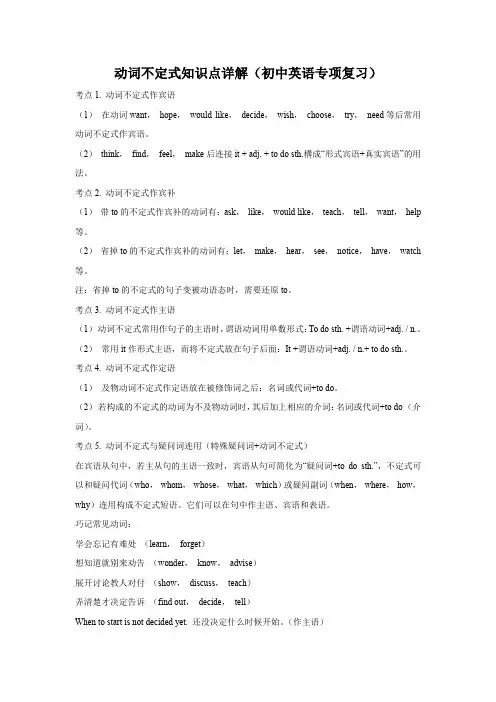
动词不定式知识点详解(初中英语专项复习)考点1. 动词不定式作宾语(1)在动词want,hope,would like,decide,wish,choose,try,need等后常用动词不定式作宾语。
(2)think,find,feel,make后连接it + adj. + to do sth.構成“形式宾语+真实宾语”的用法。
考点2. 动词不定式作宾补(1)带to的不定式作宾补的动词有:ask,like,would like,teach,tell,want,help 等。
(2)省掉to的不定式作宾补的动词有:let,make,hear,see,notice,have,watch 等。
注:省掉to的不定式的句子变被动语态时,需要还原to。
考点3. 动词不定式作主语(1)动词不定式常用作句子的主语时,谓语动词用单数形式:To do sth. +谓语动词+adj. / n.。
(2)常用it作形式主语,而将不定式放在句子后面:It +谓语动词+adj. / n.+ to do sth.。
考点4. 动词不定式作定语(1)及物动词不定式作定语放在被修饰词之后:名词或代词+to do。
(2)若构成的不定式的动词为不及物动词时,其后加上相应的介词:名词或代词+to do (介词)。
考点5. 动词不定式与疑问词连用(特殊疑问词+动词不定式)在宾语从句中,若主从句的主语一致时,宾语从句可简化为“疑问词+to do sth.”,不定式可以和疑问代词(who,whom,whose,what,which)或疑问副词(when,where,how,why)连用构成不定式短语。
它们可以在句中作主语、宾语和表语。
巧记常见动词:学会忘记有难处(learn,forget)想知道就别来劝告(wonder,know,advise)展开讨论教人对付(show,discuss,teach)弄清楚才决定告诉(find out,decide,tell)When to start is not decided yet. 还没决定什么时候开始。
9Aunit3语法(一)动词不定式用法动词不定式没有人称和数的变化,在句中不能独立作谓语。
但动词不定式具有名词、形容词和副词特征,在句中可以作主语、宾语、宾语补足语、定语、表语和状语等多种成分。
另外,动词不定式具有动词特点,可以有自己的宾语和状语,组成动词不定式短语。
动词不定式的肯定形式是to+do;其否定形式是not to +do。
下面以动词不定式在句中的作用来予以详细说明。
1.作主语可以直接作主语。
如: To ee i to beieve.但在英语中,常用it作形式主语,真正的主语即动词不定式放在后面。
如:It' wrong to e a cientit.The firt ime,ue,ive,in order等词后面。
如:I come to ee ou.He run fat in order to get there in time.b.原因状语:放在orr,gad,urfortabe to _________ A it B it on C beat D be at on3 I ______ necear to return the boo tomorrow?A thiB that Cit D which4 I'm afraid the woud not aow him ________ hereA to moeB moingC moeD moe5 Mother tod me ________ the water before I dran itA boiingB boied Cboi D to boi6 On m wa home, I toe B to become C be D /30 You’d better ________a ret nowA to haveB haveC havingD had31 Than ou for ________me the ecretA teingB teC to teD tod32 I ued to______ in the countride, now I am ued to_____ in the citA iving; iveB iving; ivingC ive; ivingD ive; ive33 The detective i bu_______ cue and he ha _______ omevauabe Chinaing __________A trong and trongB tronger and trongC tronger and trongerD trong and tronger37 The ChinaAmericaShenyangBeijingTianjinShanghaie to choo eterda昨天你们的老师为什么没来学校呢提出两种或两种以上的情况,要求对方选择一种,这种疑问句叫选择疑问句。
动词不定式知识点详解(初中英语专项复习)一、Infinitives after nouns名词+动词不定式1:不定式做后置定语,通常位于被修饰的名词之后。
如果不定式的动词是及物动词vt的话,则要带上相应的宾语;不及物动词vi的话,则不需要宾语。
1. I have a lot of work to do.我有一堆工作要做。
2. I need a pen to write with.我需要一支笔去写作。
二、Infinitives as subject动词不定式当主语2:不定式做主语的时候,通常置于句首,用于说明概念或动作。
To get up early is good for our health.早起对我们身体好。
To master a language is not an easy thing.教一门语言并不是件容易的事。
3:常见的用it作形式主语的句型有:It takes / took + sb. +一段时间+ to do sth.It takes me 30 minutes to walk to school.我每天华半小时走路上学。
4:不定式的复合结构:It was very hard for him to do the job.很难让他做干这个事。
It is clever of him to work hard at English.努力学英语的他真是明智了。
归纳句型:It is/was + adj. +___/__ sb. +__________ 辨别It's for sb.和It's of sb.① for sb. 常用于表示事物的特征特点,表示客观形式的形容词,如easy, hard, difficult,, impossible等:It's hard for him to learn English well.学好英语对他来说是很难的。
① of sb.的句型一般用表示人物的性格,品德,表示主观感情或态度的形容词如good, kind, nice, clever, foolish, right。
动词不定式知识点详解(初中英语专项复习)辨析谓语动词VS非谓语动词1.谓语动词:顾名思义,在句中充当谓语,形式与句子时态相关。
例如:一般现在时态,谓语动词有原形和三单两种形式。
He gets up at 5:00 o’clock every day.一般过去时态,谓语动词形式为过去式。
We went to Hong Kong last summer.2.非谓语动词:是相对于谓语动词而言的,非谓语动词不担任谓语成分,且具有其他词类特征的动词形式,即不定式,动名词和分词(现在分词和过去分词)。
例如:My teacher told me not to make noise in class.Watching movies help me learn English.The man standing under the tree is my father.I had my hair cut yesterday.非谓语动词不定式1.动词不定式的结构:肯定形式:to +动词原形。
否定形式:not+ to +动词原形。
2.动词不定式的用法(1)作主语例句:To learn English is important.=It is important to learn English.To walk to school takes me 20 minutes.=It takes me 20 minutes to walk to school.注意:在It is… to…”的句型中,it是形式主语,真正的主语是不定式,使用这种结构,可以避免句子的头重脚轻。
通常不定式被视为第三人称单数,所以谓语动词用单数。
It作形式主语常见结构:▲ “It is + adj./n+(for sb.) to do sth .例:It is important for us to keep a balanced diet.▲ It is + adj.+of sb+ to do sth(在kind,good, nice, clever等表示人的品质的形容词后,介词要用of)例:It is silly of you to lend him money again.▲ It takes sb. +一段时间+ to do sth.例:It takes me three hours to finish the task.作表语例句:My dream is to be a teacher.作宾语(动词+to do)例句:I want to play with you.I hope to travel around the world.常见动词:want, wish, hope, like, begin, start, help, agree, refuse, promise, learn, forget, know, need, try等。
动词不定式知识点详解(初中英语专项复习)考向一动词不定式的结构和句法功能动词不定式的结构动词不定时的构成:不定式的基本形式为:to+动词原形,有时可以不用to,这里的to 是不定式符号,本身无词义,动词不定式的否定形式是not+(to+)动词原形。
肯定式:to + 动词原形It’s nice to meet you.(2)否定式:not to + 动词原形He told me not to leave this room(to是不定式符号,无意义,有时可以不带)动词不定式的句法功能不定式作主语动词不定式作主语时,常用it作形式主语,而将真正的主语放在句末其结构为:①It is +adj.+for/of sb.+(not)to do sth.意为"做某事对某人来说是……"。
①It takes sb.+some time+to do sth.意为"做某事花费某人多长时间"如:To learn English well is useful.→ It is useful to learn English well.It’s important for us to protect the environment.注意:在kind,good,nice,clever等表示人的品质的形容词后,不用for而用of。
如:It's very kind of you to help me. 你帮助我真是太好啦。
不定式作宾语有些谓语动词后只能用不定式作宾语,常见的这类词是表示命令、打算或希望的,如:would like, like, want, wish, hope, decide, plan, expect等。
如:Would you like to see a film this evening? 你今晚想去看电影吗?①在find, think后跟不定式作宾语时,常用it代替,而将真正的宾语放在后面。
如:I find it easy to read English every day.3.不定式作宾语补足语tell, ask, want, allow, warn, advise, invite, get, encourage后常跟动词不定式作宾语补足语。
动词不定式知识点详解(初中英语专项复习)1. 动词不定式作宾语(1)接不定式作宾语的动词(“动词+to do” 结构)常见的有:learn 学会plan 计划decide 决定try 尽力choose 选择agree 同意refuse 拒绝pretend 假装offer 主动would like / want 想要expect 期望hope / wish 希望promise 承诺afford 负担得起prefer 喜欢help 帮助(help to do / help do) like 喜欢(like to do / doing)continue 继续(continue to do / doing)begin / start 开始(begin / start to do / doing)如:I would like to have a sandwich. 我想要吃一个三明治。
(2)动词不定式作宾语,置句末,前面用it指代不定式,it是形式宾语。
如:We found it difficult to understand what you said. 我们发现很难理解你所说的话。
(3)有的动词在不定式前可加上疑问词(who,what,which等)作宾语(即“动词+疑问词+to do” 结构),常见的有:show 表明、指示;know 知道;tell 告诉;teach 教;learn 学习;decide 决定。
如:Larry didn’t know how to tell her the bad news. 拉里不知道如何告诉她这个坏消息。
2. 动词不定式作宾语补足语(1)接不定式作宾语补足语的动词(动词+sb.+to do结构,否定式“动词+sb.+not to do” )常见的有:tell 告诉ask 请order 命令warn 警告teach 教want 想要wish 希望expect 期望encourage 鼓励allow 允许invite 邀请advise 建议require 要求force 强迫如:Do you want me to find out the phone number? 你想要我找出那个电话号码吗?(2)有些及物动词,接不定式作宾语补足语时(动词+sb.+do ),要省略to。
动词不定式讲解初中英语语法动词不定式讲解初中英语语法动词不定式指通常由to加上动词原形 (如to write) 所构成的一种非限定性动词形式,但在有些情况下to可以省略。
动词不定式有进展体和完成体(如上to be writing,to have written),也有被动态(如to be written),所有的主动词,不管是及物动词还是不及物动词,也不管是动作动词还是状态动词,都有不定式形式。
助动词除be和have外,没有不定式形式。
动词不定式在语法功能上可作主语、宾语、表语、定语和状语。
1)不定式构造作主语1.Te get contact with his family in Taiwan made him extremely happy since they separated more than 40 years ago.2.To finish that task in such a short time is really a challenge.在上述情况下,如果不定式较长,显得头重脚轻,那么可由代词让作形式主语(形式主语it不可由that或this等其他代词代替),而将不定式放到后面。
如:1.It made him extremely happy to get contact with his family in Taiwan since they separated more than 40 years ago.2.John admitted that it is always difficult for him to be on time.不定式构造所表示的动作是谁做的,即不定式的逻辑主语,通常可以通过for sb. to do sth. 构造表达: 1.It is quite important for us to read good books during a generalreview. 2.It is not difficult fot those talented students to pass the exam. 在某些形容词(如careless,clever,considerate,foolish,good,impolite,kind, naughty,nice,silly,stupid等)作表语时,不定式后可以加of来引导出其逻辑主语: 1.It is very kind of you to tell me the truth. 2.It is stupid of him to do such a silly thing.及物动词+带to的不定式构造: 只能跟动词不定式的动词,常见的有: afford, agree, aim, appear, ask, believe,care,claim,decide demand, desire, determine, expect,fail, happen, hesitate, hope, intend, learn, long,manage, offer, pretend, promise, prepare, refuse,seek, swear, undertake,want, wish等。
初中英语语法之动词不定式详解动词不定式概念引入1. 动词不定式名言:(1)动词不定式作表语To lose is to learn. 失败就是学习。
(2)动词不定式作主语It is better to give than to take. 给予比接受更好。
(3)不定式作宾语Expect to be treated as you have treated others.你怎样待别人,就指望别人怎样待你。
(4)不定式作宾补Adversity causes some men to break,others to break records.逆境使一些人崩溃,也使一些人破记录。
(5)不定式作定语There is a time to talk and a time to act.该说的时候说,该做的时候做。
(6)不定式作目的状语To find the exact answer,one must first ask the exact question.要找到确切的答案,首先必须提出确切的问题。
2. 动词不定式定义:动词不定式是一种非谓语形式(不能作谓语),基本形式是to do形式(to是不定式符号的标志,无意义,可以不翻译) 肯定式:to + 动词原形否定式:not to + 动词原形2用法讲解1.动词不定式的特征动词不定动式是一种非谓语动词形式,它没有人称和数的变化,在句子中不能作谓语,但可以作除谓语之外的其它任何句子成分(主语、表语、宾语、宾语补足语、定语和状语);动词不定式具有名词、形容词和副词的特征,同时还保持动词的某些特点,既可以有自己的宾语和状语,动词不定式和它的宾语和状语构成不定式短语。
2. 动词不定式在句子中的作用动词不定式是由to+动词原形构成,在句中起名词,形容词和副词的作用,可以担任除谓语以外的其它任何成分。
(1)动词不定式作主语。
例如:To master a language is not an easy thing.掌握一门语言不是一件容易的事情。
To teach English is my favorite. 教英语是我的爱好。
It's my pleasure to help you. 很乐意帮助你。
(2)动词不定式作宾语。
某些及物动词可以用动词不定式作宾语,这些动词有decide, begin, help, want, wish, like, forget, learn, ask等。
例如:I like to help others if I can. 如果有可能的话,我喜欢帮助别人。
I want to buy a new car when I have enough money.我有钱时想买一辆新车。
(3)动词不定式作宾语补足语。
例如:We expect you to be with us. 我们希望你和我们在一起。
Please ask him to come here quickly. 请叫他快过来。
(4)动词不定式作表语。
例如:What I should do is to finish the task soon.我应该做的是赶快完成任务。
The most urgent thing is to find the boy immediately. 当务之急是马上去找孩子。
(5)动词不定式作定语。
例如:There are many ways to solve the problem.有许多方法能解决这个问题。
I have something important to tell you.我有重要的事情要告诉你。
(6)不定式作状语。
例如:We went to the hospital to see our teacher.我们去医院看了我们的老师。
She is making a test to get a kind of useful medicine from aTibetflower.她在做试验,从一种西藏花中提取某种有用的药物3.不定式后接特殊疑问词的用法不定式可以和疑问代词who, what, which及疑问副词when, how, where等连用,构成不定式短语,在句子中作主语、宾语、表语等。
例如:I don't know what to say. 我不知道说什么。
Can you tell me how to make a paper boat?你能告诉我怎样做一只纸船吗?I don't know which topic to choose. 我不知道选哪个题目。
Where to stay for the night is a problem. 晚上在哪儿过夜还是个问题。
4.不定式的重要句型(1)It’s+adj.+for (of)sb. to do sth.当不定式作主语时,通常用it作为形式主语,而把真正的主语不定式结构后置。
例如:To meet you is a great pleasure. =It is a great pleasure to meet you.非常高兴见到你。
To plant trees every year is necessary.= It is necessary to plant trees every year.每年植树是必要的。
这种结构往往还要有一个逻辑主语。
一般使用下面的结构:1)It is +adj. +of sb.+to do sth.It is selfish of you to eat the whole birthday cake.你真是太自私了,吃光了整个蛋糕。
2)It is +adj. + for sb. + to do sth.It is difficult for me to learn English well.对我来说学好英语太难了。
【注意】for和of引导的不定式结构的区别表语形容词的语义不同是区别 for 结构和 of 结构的最重要标志。
1)在“It is(was)+adj.+for sb.+to do sth.”的句式中,作表语的形容词大多是表事物性质的静态形容词,如:essential,easy,difficult, important,necessary,possible,hard等等,这类形容词与for后面的名词(代词)关系不密切,无意义上的主表关系。
例如:It is necessary for us to practise speaking English every day.每天练习说英语对我们来说是很有必要的。
2)在“It is(was)+adj.+of sb.…”的句式中,作表语的形容词大多是表示人物特征的形容词。
如:brave,careless,careful,clever,cruel,foolish,good,honest,(un)kind noble,polite,right,rude,sweet,silly,stupid,wrong等等。
这些表示人物特征的形容词与of后的名词关系十分密切,有意义上的主表关系。
例如:It is kind of you(=You are kind)to send me a nice present.谢谢你送我这么好的礼物。
It was stupid of her(=She was stupid)to make such a mistake.出这样的错她真是太蠢了。
(2)主语+动词+too+形容词/副词+(for+sb.)+to+动词原形表示“……太……而不能……”。
例如:He walked too slowly to catch up with me.他走得太慢而不能跟上我。
It is too dark in this room for me to read a book.房间太暗,使我无法看书。
This problem is too difficult for them to settle.这对他们来说真是一个难解的问题。
(3)主语+动词+……形容词/副词+enough+(for sb.)+to+动词原形,表示“……对某人足以……”。
例如:We need several men strong enough to do the work.我们需要几个强壮得足以做这件工作的人。
They bought a house large enough for ten persons to live in.我们买了一栋房子,大得足以供十个人住。
He is competent enough to fill that position.他足以胜任那职位。
(4)主语+动词+enough+名词+to+动词原形,表示“……对某人足以……”。
例如:He has enough money (=money enough) to buy a car.他有足够的钱买一辆汽车。
He hasn’t enough sense to realize hi s mistakes.他没有足够的辨别力去认识自己的错误。
巩固练习I.单项选择。
1. ________ late in the morning, Bob turned off the alarm.A. To sleepB. SleepingC. SleepD. Having slept2. I'm going to the supermarket this afternoon. Do you have anything ________?A. to be buyingB. to buyC. for buyingD. bought3. I’ve worked with children before, so I know what ________ in my new job.A. expectedB. to expectC. to be expectingD. expects4. She watched the children ________ in the garden.A. to be playedB. to playC. playD. to have played5. The teacher asked us ________ so much noise.A. don't makeB. not makeC. not makingD. not to make6.-I usually go there by train.-Why not _______ by boat for a change?A. to try goingB. trying to goC. to try and goD. try going7. Paul doesn't have to be made _______. He always works hard.A. learnB. to learnC. learnedD. learning8. Tell him _______ the window.A. to shut notB. not to shutC. to not shutD. not shut9. She pretended _______ me when I passed by.A. not to seeB. not seeingC. to not seeD. having not seen10. Mrs. Smith warned her daughter _______ after drinking.A. never to driveB. to never driverC. never drivingD. never drive11 . The patient was warned _______ oily food after the operation.A. to eat noB. eating notC. not to eatD. not eating12. I saw him _______ out of the room.A. goB. had goneC. has goneD. goes13. —The light in the office is still on.—Oh, I forgot _______.A. turning it offB. turn it offC. to turn it offD. having turned it off14. He always prefers _______ a bicycle. rather than _______ on a crowded bus.A. to ride;rideB. riding;rideC. ride;to rideD. to ride;riding15. The price is too low for customers________.A. to believeB. believingC. believedD. believe [真题链接]1. The joke was so funny that it made him ____ again and again.A. laughB. to laughC. laughedD. laughs2. We stopped _________, but there was not any sound.A. to listenB. listensC. listenD. Listening3. Mr. Smith told his son _____ the football match because of the exam.A. not to watchB. to not watchC. not watchingD. doesn’t watchII.把下列的结果状语从句改为enough to或too…to的句式。